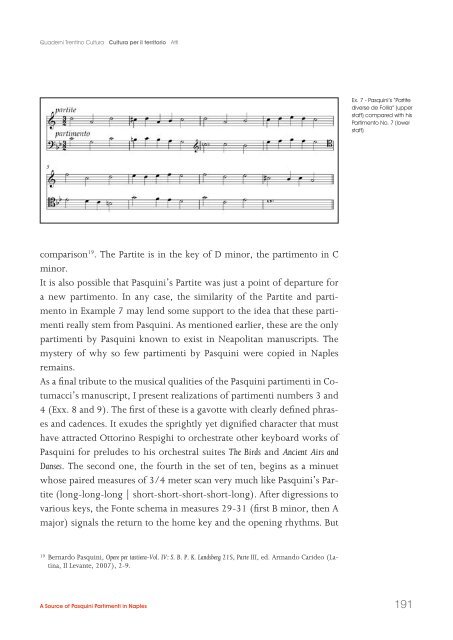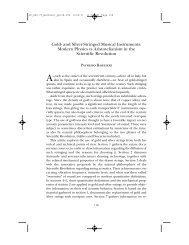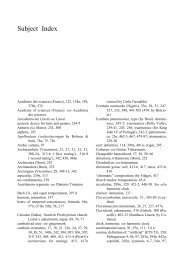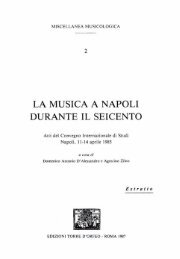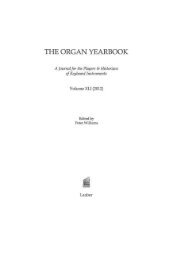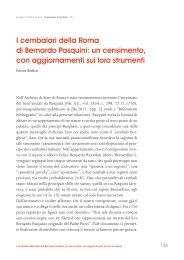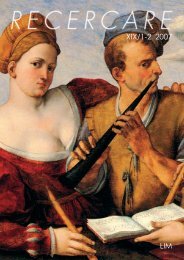- Page 2:
17 Quaderni Trentino Cultura Serviz
- Page 5 and 6:
PASQUINI SYMPOSIUM, Smarano, 2010 P
- Page 8 and 9:
Quaderni Trentino Cultura Cultura p
- Page 10 and 11:
Quaderni Trentino Cultura Cultura p
- Page 16 and 17:
Quaderni Trentino Cultura Cultura p
- Page 18 and 19:
Quaderni Trentino Cultura Cultura p
- Page 20 and 21:
Quaderni Trentino Cultura Cultura p
- Page 22 and 23:
Quaderni Trentino Cultura Cultura p
- Page 24 and 25:
Quaderni Trentino Cultura Cultura p
- Page 26 and 27:
Quaderni Trentino Cultura Cultura p
- Page 28 and 29:
Quaderni Trentino Cultura Cultura p
- Page 30 and 31:
Quaderni Trentino Cultura Cultura p
- Page 32 and 33:
Quaderni Trentino Cultura Cultura p
- Page 34 and 35:
Quaderni Trentino Cultura Cultura p
- Page 36 and 37:
Quaderni Trentino Cultura Cultura p
- Page 38 and 39:
Quaderni Trentino Cultura Cultura p
- Page 40 and 41:
Quaderni Trentino Cultura Cultura p
- Page 42 and 43:
Quaderni Trentino Cultura Cultura p
- Page 44 and 45:
Quaderni Trentino Cultura Cultura p
- Page 46 and 47:
Quaderni Trentino Cultura Cultura p
- Page 48 and 49:
Quaderni Trentino Cultura Cultura p
- Page 50 and 51:
Quaderni Trentino Cultura Cultura p
- Page 52 and 53:
Quaderni Trentino Cultura Cultura p
- Page 54 and 55:
Quaderni Trentino Cultura Cultura p
- Page 56 and 57:
Quaderni Trentino Cultura Cultura p
- Page 58 and 59:
Quaderni Trentino Cultura Cultura p
- Page 60 and 61:
Quaderni Trentino Cultura Cultura p
- Page 62 and 63:
Quaderni Trentino Cultura Cultura p
- Page 64 and 65:
Quaderni Trentino Cultura Cultura p
- Page 66 and 67:
Quaderni Trentino Cultura Cultura p
- Page 68 and 69:
Quaderni Trentino Cultura Cultura p
- Page 70 and 71:
Quaderni Trentino Cultura Cultura p
- Page 72 and 73:
Quaderni Trentino Cultura Cultura p
- Page 74 and 75:
Quaderni Trentino Cultura Cultura p
- Page 76 and 77:
Quaderni Trentino Cultura Cultura p
- Page 78 and 79:
Quaderni Trentino Cultura Cultura p
- Page 80 and 81:
Quaderni Trentino Cultura Cultura p
- Page 82 and 83:
Quaderni Trentino Cultura Cultura p
- Page 84 and 85:
Quaderni Trentino Cultura Cultura p
- Page 86 and 87:
Quaderni Trentino Cultura Cultura p
- Page 88 and 89:
Quaderni Trentino Cultura Cultura p
- Page 90 and 91:
Quaderni Trentino Cultura Cultura p
- Page 94:
III
- Page 99:
VIII
- Page 104 and 105:
XIII
- Page 107 and 108:
XVI
- Page 109 and 110:
XVIII
- Page 112 and 113:
XXI
- Page 114 and 115:
XXIII
- Page 116 and 117:
XXV
- Page 118 and 119:
XXVII
- Page 120 and 121:
XXIX
- Page 122 and 123:
XXXI
- Page 124 and 125:
XXXIII
- Page 126 and 127:
XXXV
- Page 128 and 129:
XXXVII
- Page 130:
XXXIX
- Page 133 and 134:
XLII
- Page 135 and 136:
XLIV
- Page 137 and 138:
XLVI
- Page 139 and 140:
XLVIII
- Page 141 and 142:
L Indice alfabetico per incipit, ti
- Page 143 and 144:
LII Nel mio pensiero è nata Non ce
- Page 145 and 146:
92 Quaderni Trentino Cultura Cultur
- Page 147 and 148:
94 Quaderni Trentino Cultura Cultur
- Page 149 and 150:
96 Quaderni Trentino Cultura Cultur
- Page 151 and 152:
98 Quaderni Trentino Cultura Cultur
- Page 153 and 154:
100 Quaderni Trentino Cultura Cultu
- Page 155 and 156:
102 Quaderni Trentino Cultura Cultu
- Page 157 and 158:
104 Quaderni Trentino Cultura Cultu
- Page 159 and 160:
106 Quaderni Trentino Cultura Cultu
- Page 161 and 162:
108 Quaderni Trentino Cultura Cultu
- Page 163 and 164:
110 Quaderni Trentino Cultura Cultu
- Page 165 and 166:
112 Quaderni Trentino Cultura Cultu
- Page 167 and 168:
114 Quaderni Trentino Cultura Cultu
- Page 169 and 170:
116 Quaderni Trentino Cultura Cultu
- Page 171 and 172:
118 Quaderni Trentino Cultura Cultu
- Page 173 and 174:
120 Quaderni Trentino Cultura Cultu
- Page 175 and 176:
122 Quaderni Trentino Cultura Cultu
- Page 177 and 178:
Fig. 1 - Alessandro Cecconi, Laudat
- Page 179 and 180:
Fig. 3 - Vincenzo Albrici, Fader W
- Page 181 and 182:
128 Quaderni Trentino Cultura Cultu
- Page 183 and 184:
130 Quaderni Trentino Cultura Cultu
- Page 185 and 186:
132 Quaderni Trentino Cultura Cultu
- Page 187 and 188:
134 Quaderni Trentino Cultura Cultu
- Page 189 and 190:
136 Quaderni Trentino Cultura Cultu
- Page 191 and 192:
138 Abstract Quaderni Trentino Cult
- Page 193 and 194: 140 Quaderni Trentino Cultura Cultu
- Page 195 and 196: 142 Quaderni Trentino Cultura Cultu
- Page 197 and 198: 144 Quaderni Trentino Cultura Cultu
- Page 199 and 200: 146 Quaderni Trentino Cultura Cultu
- Page 201 and 202: 148 Quaderni Trentino Cultura Cultu
- Page 203 and 204: 150 Quaderni Trentino Cultura Cultu
- Page 205 and 206: 152 Quaderni Trentino Cultura Cultu
- Page 207 and 208: Affetti cantabili from Frescobaldi
- Page 209 and 210: 156 Quaderni Trentino Cultura Cultu
- Page 211 and 212: 158 Quaderni Trentino Cultura Cultu
- Page 213 and 214: 160 Quaderni Trentino Cultura Cultu
- Page 215 and 216: 162 Quaderni Trentino Cultura Cultu
- Page 217 and 218: 164 Quaderni Trentino Cultura Cultu
- Page 219 and 220: 166 Quaderni Trentino Cultura Cultu
- Page 221 and 222: Fig. 1 Fig. 2 Fig. 3 Fig. 4 Fig. 5
- Page 223 and 224: Fig. 11 Fig. 12 Fig. 13 Fig. 14 Fig
- Page 225 and 226: Fig. 19 b Fig. 20 Fig. 21 Fig. 22 F
- Page 227 and 228: Fig. 25 Fig. 26 Fig. 27 a, b 174 Qu
- Page 229 and 230: Tab. 1 continue 176 Quaderni Trenti
- Page 231 and 232: 178 Quaderni Trentino Cultura Cultu
- Page 233 and 234: 180 Quaderni Trentino Cultura Cultu
- Page 235 and 236: 182 Quaderni Trentino Cultura Cultu
- Page 237 and 238: Ex. 1 - The Fonte schema from an in
- Page 239 and 240: Ex. 3 - Partimento No. 1 by Pasquin
- Page 241 and 242: Ex. 4 - A realizationf of Pasquini
- Page 243: Table 1 - The ten incipits of the P
- Page 247 and 248: 194 Abstract Quaderni Trentino Cult
- Page 249 and 250: 196 Quaderni Trentino Cultura Cultu
- Page 251 and 252: 198 Quaderni Trentino Cultura Cultu
- Page 253 and 254: 200 Quaderni Trentino Cultura Cultu
- Page 255 and 256: 202 Quaderni Trentino Cultura Cultu
- Page 257 and 258: Tavola 2 204 Quaderni Trentino Cult
- Page 259 and 260: 206 Quaderni Trentino Cultura Cultu
- Page 261 and 262: 208 Quaderni Trentino Cultura Cultu
- Page 263 and 264: 210 Quaderni Trentino Cultura Cultu
- Page 265 and 266: 212 Quaderni Trentino Cultura Cultu
- Page 267 and 268: 214 Quaderni Trentino Cultura Cultu
- Page 269 and 270: 216 Quaderni Trentino Cultura Cultu
- Page 271 and 272: 218 Quaderni Trentino Cultura Cultu
- Page 273 and 274: 220 Quaderni Trentino Cultura Cultu
- Page 275 and 276: 222 Quaderni Trentino Cultura Cultu
- Page 277 and 278: 224 Quaderni Trentino Cultura Cultu
- Page 279 and 280: 226 Quaderni Trentino Cultura Cultu
- Page 281 and 282: 228 Quaderni Trentino Cultura Cultu
- Page 283 and 284: 230 Quaderni Trentino Cultura Cultu
- Page 285 and 286: 232 Quaderni Trentino Cultura Cultu
- Page 287 and 288: 234 Quaderni Trentino Cultura Cultu
- Page 289 and 290: 236 Quaderni Trentino Cultura Cultu
- Page 291 and 292: 238 Quaderni Trentino Cultura Cultu
- Page 293 and 294: 240 Quaderni Trentino Cultura Cultu
- Page 295 and 296:
242 Quaderni Trentino Cultura Cultu
- Page 297 and 298:
244 Quaderni Trentino Cultura Cultu
- Page 299 and 300:
Abhandlung 1: Fresc. 1ff Abhandlung
- Page 301 and 302:
Abhandlung 11: VivaldiRV522 Abhandl
- Page 303 and 304:
Abhandlung 21: InversusFugaWKIa Abh
- Page 305 and 306:
Abhandlung 29: FgG Abhandlung 30: F
- Page 307 and 308:
254 Abstract Quaderni Trentino Cult
- Page 309 and 310:
256 Quaderni Trentino Cultura Cultu
- Page 311 and 312:
258 Quaderni Trentino Cultura Cultu
- Page 313 and 314:
260 Quaderni Trentino Cultura Cultu
- Page 315 and 316:
262 Quaderni Trentino Cultura Cultu
- Page 317 and 318:
264 Acting at the Keyboard Quaderni
- Page 319 and 320:
266 Quaderni Trentino Cultura Cultu
- Page 321 and 322:
268 Quaderni Trentino Cultura Cultu
- Page 323 and 324:
270 Quaderni Trentino Cultura Cultu
- Page 325 and 326:
272 Quaderni Trentino Cultura Cultu
- Page 327 and 328:
274 Quaderni Trentino Cultura Cultu
- Page 329:
Finito di stampare nel mese di magg


